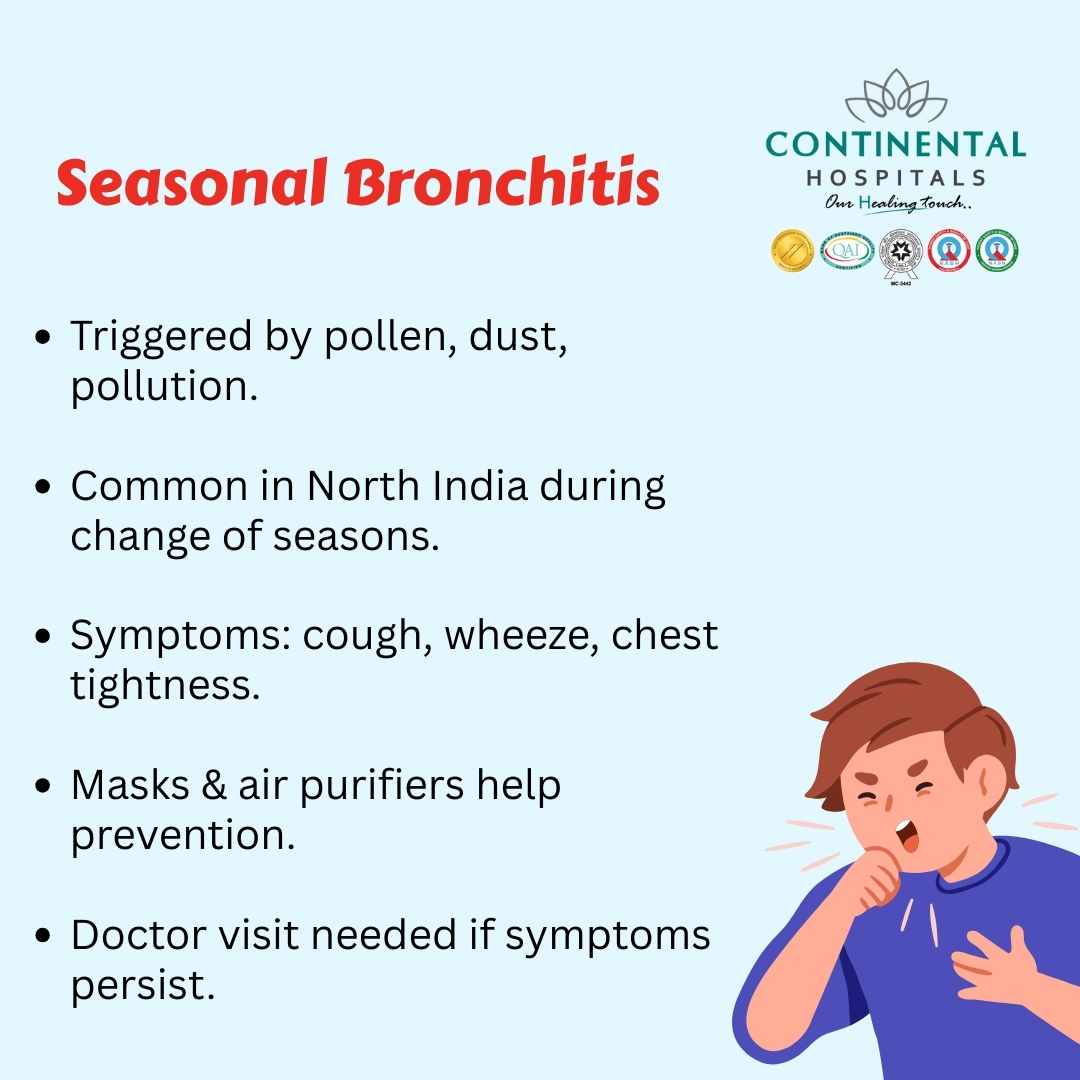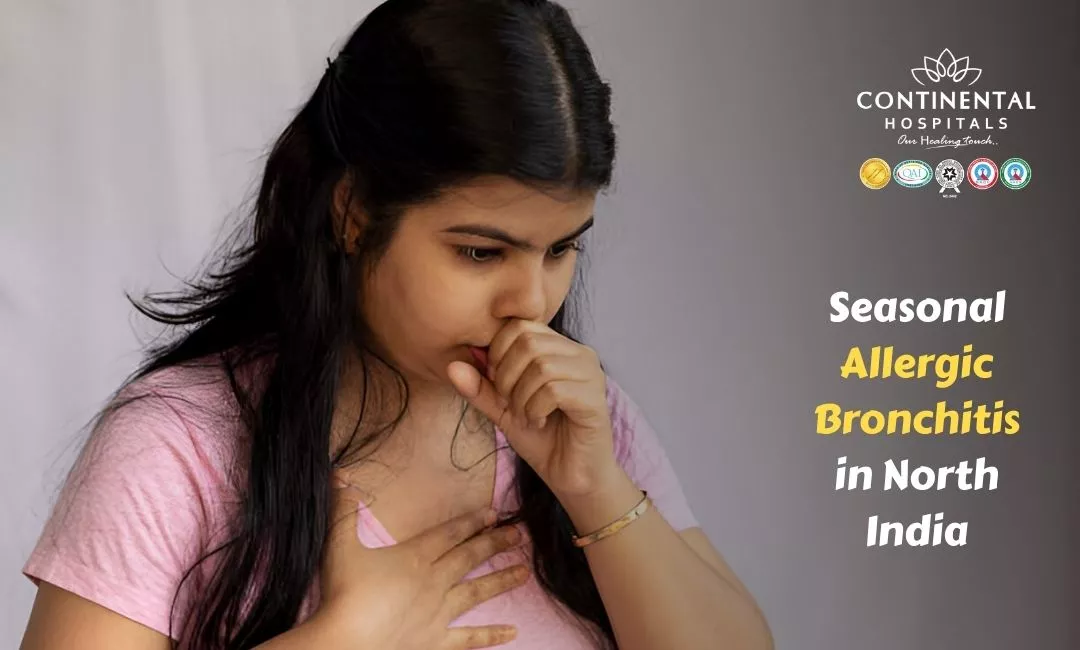Seasonal allergic bronchitis is a common respiratory condition in North India, particularly affecting people during certain times of the year. It is often triggered by changes in weather, pollen, dust, and other environmental allergens. Understanding what causes this condition, its symptoms, and how to manage it is essential for protecting your respiratory health.
What Is Seasonal Allergic Bronchitis?
Seasonal allergic bronchitis is an inflammation of the bronchial tubes caused by an allergic reaction to airborne particles. Unlike regular bronchitis, which is often caused by infections, allergic bronchitis occurs when your immune system overreacts to allergens such as pollen, mold spores, dust, or pollution.
In North India, seasonal changes bring an increase in pollen from trees, grasses, and crops. Dust from dry winds and construction activities also contributes to the rise of allergens in the air. People with sensitive airways or a history of asthma are more prone to developing this condition during these periods.

🥗 Healthy Plate Challenge
🍽 Add Your Favorite Dish
Pick Your 6 favorite foods, eat, and see the results.Drag & drop foods onto your plate.
Drop Food Here
Common Causes in North India
Pollen Exposure: During spring and early summer, pollen levels rise significantly, triggering allergic reactions. Trees, flowers, and crops release pollen into the air, which can irritate the airways.
Dust and Pollution: Urban areas in North India often face high levels of dust and air pollution. Dust particles and pollutants settle in the respiratory tract, causing inflammation and bronchial irritation.
Changes in Weather: Sudden changes in temperature or humidity can worsen respiratory symptoms. Cold, dry winds can irritate the bronchial tubes, making it easier for allergens to cause reactions.
Mold and Fungal Spores: Damp areas and seasonal rainfall can lead to the growth of mold, which releases spores into the air and triggers allergic bronchitis in sensitive individuals.
Recognizing the Symptoms
Seasonal allergic bronchitis shares some symptoms with common colds, but there are specific signs to watch for:
- Persistent coughing, especially during mornings and evenings
- Wheezing or difficulty breathing
- Tightness in the chest
- Runny or blocked nose
- Sneezing episodes
- Itchy throat and eyes
- Fatigue caused by disrupted sleep due to coughing
If these symptoms appear repeatedly during specific seasons, it may indicate seasonal allergic bronchitis rather than a simple viral infection.
Who Is at Risk?
Certain groups are more vulnerable to seasonal allergic bronchitis:
- People with a history of asthma or allergic rhinitis
- Children and older adults with sensitive airways
- Residents of urban areas with high pollution
- Individuals with prolonged exposure to dust, pollen, or industrial fumes
Identifying your risk can help in early prevention and timely treatment.
How Is Seasonal Allergic Bronchitis Diagnosed?
Doctors typically begin with a detailed medical history and physical examination. They may ask about the timing of symptoms, exposure to potential allergens, and family history of allergies or asthma.
Diagnostic tests may include:
Allergy Testing: Skin or blood tests to identify specific allergens
Spirometry: Measures lung function to check for airway obstruction
Chest X-rays: To rule out infections or other lung conditions
Early diagnosis ensures better management and prevents complications such as chronic bronchitis or asthma attacks.
Treatment Options
Managing seasonal allergic bronchitis involves a combination of lifestyle changes, medications, and preventive measures.
Avoiding Triggers: Limiting exposure to pollen, dust, and pollution is the first step. Keep windows closed during high pollen seasons and use air purifiers indoors. Wearing masks outdoors can also reduce inhalation of allergens.
Medications: Doctors may prescribe antihistamines, bronchodilators, or corticosteroid inhalers to control inflammation and relieve symptoms. These medications help open airways and reduce allergic reactions.
Nasal Sprays: Saline or steroid nasal sprays can relieve nasal congestion and irritation caused by airborne allergens.
Hydration and Diet: Drinking sufficient water helps thin mucus and eases coughing. Including anti-inflammatory foods like green vegetables, fruits, and nuts may support lung health.
Regular Check-Ups: Continuous monitoring by a healthcare provider ensures the condition remains under control, especially for people with asthma.
Preventive Measures
Prevention is crucial in managing seasonal allergic bronchitis. Here are effective strategies:
- Stay indoors during peak pollen times
- Use air filters and maintain clean living spaces
- Wear protective masks in dusty or polluted areas
- Shower and change clothes after outdoor exposure to remove allergens
- Monitor air quality updates in your city
Why Choose Continental Hospitals for Seasonal Allergic Bronchitis?
Continental Hospitals offers specialized respiratory care for patients suffering from seasonal allergic bronchitis. Here’s what sets us apart:
Experienced Pulmonologists: Our team includes experts in diagnosing and treating allergic and chronic bronchitis.
Advanced Diagnostic Tools: We provide accurate allergy testing, spirometry, and imaging facilities to pinpoint the cause of symptoms.
Comprehensive Care: From preventive advice to personalized treatment plans, our approach focuses on long-term respiratory health.
Patient-Centric Approach: Our doctors take time to understand each patient’s lifestyle, triggers, and medical history to provide effective solutions.
Choosing Continental Hospitals ensures access to advanced treatments, expert care, and ongoing support for respiratory wellness.
When to See a Doctor
If you experience persistent coughing, wheezing, or shortness of breath during seasonal changes, it is essential to consult a pulmonologist. Early intervention can prevent complications and improve quality of life.
Conclusion
Seasonal allergic bronchitis is a manageable condition if recognized early and treated effectively. Understanding the triggers, recognizing the symptoms, and following preventive measures can make a significant difference. North India’s seasonal weather patterns and pollution levels increase the risk, but with timely medical care, you can maintain healthy lungs.
If you're experiencing symptoms, don't wait—contact our healthcare team at Continental Hospitals today. Visit our best pulmonologists in Hyderabad.
.webp)














